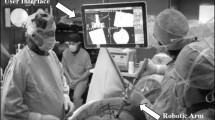Abstract
Purpose
Current solutions for navigated spine surgery remain hampered by restrictions in surgical workflow as well as a limited versatility and applicability. Against this background, we report the first experience of navigated spinal instrumentation with the mobile AIRO® intraoperative computed tomography (iCT) scanner.
Methods
AIRO® iCT was used for navigated posterior spinal instrumentation of 170 screws in 23 consecutive patients operated on in our Department between the first use of the system in May 2014 and August 2014. The indications for AIRO® were based on the surgical region, anatomical complexity and the need for >3 segment instrumentation. Following navigated screw insertion, screw positions were confirmed intraoperatively by a second iCT scan. CT data on screw placement accuracy were retrospectively reviewed and analyzed by an independent observer.
Results
AIRO®-based spinal navigation was easy to implement and successfully accomplished in all patients, adding around 18–34 min to the net surgery time. A systematic description of the authors’ approach, setup in the OR and workflow integration of the AIRO® is presented. Analysis of screw placement accuracy revealed 9 (5.3 %) screws with minor pedicle breaches (<2 mm). A total of 7 screws (4.1 %) were misplaced >2 mm, resulting in an accuracy rate of 95.9 %.
Conclusions
The AIRO® system is an easy-to-use and versatile iCT for navigated spinal instrumentation and provides high pedicle screw accuracy rates. Although the authors’ experience suggests that the learning curve associated with AIRO®-based spinal navigation is steep, a systematic user-based approach to the technology is required.





Similar content being viewed by others
References
Tormenti MJ, Kostov DB, Gardner PA et al (2010) Intraoperative computed tomography image-guided navigation for posterior thoracolumbar spinal instrumentation in spinal deformity surgery. Neurosurg Focus 28:E11. doi:10.3171/2010.1.FOCUS09275
Shin BJ, James AR, Njoku IU, Hartl R (2012) Pedicle screw navigation: a systematic review and meta-analysis of perforation risk for computer-navigated versus freehand insertion. J Neurosurg Spine 17:113–122. doi:10.3171/2012.5.SPINE11399
Gelalis ID, Paschos NK, Pakos EE et al (2012) Accuracy of pedicle screw placement: a systematic review of prospective in vivo studies comparing free hand, fluoroscopy guidance and navigation techniques. Eur Spine J 21:247–255. doi:10.1007/s00586-011-2011-3
Kosmopoulos V, Schizas C (2007) Pedicle screw placement accuracy: a meta-analysis. Spine (Phila Pa 1976) 32:E111–E120
Waschke A, Walter J, Duenisch P et al (2013) CT-navigation versus fluoroscopy-guided placement of pedicle screws at the thoracolumbar spine: single center experience of 4,500 screws. Eur Spine J 22:654–660. doi:10.1007/s00586-012-2509-3
Ishikawa Y, Kanemura T, Yoshida G et al (2010) Clinical accuracy of three-dimensional fluoroscopy-based computer-assisted cervical pedicle screw placement: a retrospective comparative study of conventional versus computer-assisted cervical pedicle screw placement. J Neurosurg Spine 13:606–611. doi:10.3171/2010.5.SPINE09993
Tian W, Liu Y, Zheng S, Lv Y (2013) Accuracy of lower cervical pedicle screw placement with assistance of distinct navigation systems: a human cadaveric study. Eur Spine J 22:148–155. doi:10.1007/s00586-012-2494-6
Zausinger S, Scheder B, Uhl E et al (2009) Intraoperative computed tomography with integrated navigation system in spinal stabilizations. Spine (Phila Pa 1976) 34:2919–2926
Scheufler K-M, Franke J, Eckardt A, Dohmen H (2011) Accuracy of image-guided pedicle screw placement using intraoperative computed tomography-based navigation with automated referencing, part I: cervicothoracic spine. Neurosurgery 69:782–795. doi:10.1227/NEU.0b013e318222ae16 (discussion 795)
Barsa P, Frohlich R, Benes V, Suchomel P (2014) Intraoperative portable CT-scanner based spinal navigation—a feasibility and safety study. Acta Neurochir (Wien). doi:10.1007/s00701-014-2184-8
Van de Kelft E, Costa F, Van der Planken D, Schils F (2012) A prospective multicenter registry on the accuracy of pedicle screw placement in the thoracic, lumbar, and sacral levels with the use of the O-arm imaging system and Stealth Station Navigation. Spine (Phila Pa 1976) 37:E1580–E1587
Costa F, Cardia A, Ortolina A et al (2011) Spinal navigation: standard preoperative versus intraoperative computed tomography data set acquisition for computer-guidance system: radiological and clinical study in 100 consecutive patients. Spine (Phila Pa 1976) 36:2094–2098. doi:10.1097/BRS.0b013e318201129d
Rivkin MA, Yocom SS (2014) Thoracolumbar instrumentation with CT-guided navigation (O-arm) in 270 consecutive patients: accuracy rates and lessons learned. Neurosurg Focus 36:E7. doi:10.3171/2014.1.FOCUS13499
Neo M, Sakamoto T, Fujibayashi S, Nakamura T (2005) The clinical risk of vertebral artery injury from cervical pedicle screws inserted in degenerative vertebrae. Spine (Phila Pa 1976) 30:2800–2805
Learch TJ, Massie JB, Pathria MN et al (2004) Assessment of pedicle screw placement utilizing conventional radiography and computed tomography: a proposed systematic approach to improve accuracy of interpretation. Spine (Phila Pa 1976) 29:767–773
Nottmeier EW, Crosby TL (2007) Timing of paired points and surface matching registration in three-dimensional (3D) image-guided spinal surgery. J Spinal Disord Tech 20:268–270
Ryang Y-M, Villard J, Obermuller T et al (2014) Learning curve of 3D-fluoroscopy image-guided pedicle screw placement in the thoracolumbar spine. Spine J. doi:10.1016/j.spinee.2014.10.003
Villard J, Ryang Y-M, Demetriades AK et al (2014) Radiation exposure to the surgeon and the patient during posterior lumbar spinal instrumentation: a prospective randomized comparison of navigated versus non-navigated freehand techniques. Spine 39:1004–1009. doi:10.1097/BRS.0000000000000351
Rampersaud YR, Simon DA, Foley KT (2001) Accuracy requirements for image-guided spinal pedicle screw placement. Spine (Phila Pa 1976) 26:352–359
Rahmathulla G, Nottmeier EW, Pirris SM et al (2014) Intraoperative image-guided spinal navigation: technical pitfalls and their avoidance. Neurosurg Focus 36:E3. doi:10.3171/2014.1.FOCUS13516
Conflict of interest
Peter Vajkoczy is a consultant for Aesculap and Ulrich Medical.
Author information
Authors and Affiliations
Corresponding author
Rights and permissions
About this article
Cite this article
Hecht, N., Kamphuis, M., Czabanka, M. et al. Accuracy and workflow of navigated spinal instrumentation with the mobile AIRO® CT scanner. Eur Spine J 25, 716–723 (2016). https://doi.org/10.1007/s00586-015-3814-4
Received:
Revised:
Accepted:
Published:
Issue Date:
DOI: https://doi.org/10.1007/s00586-015-3814-4




